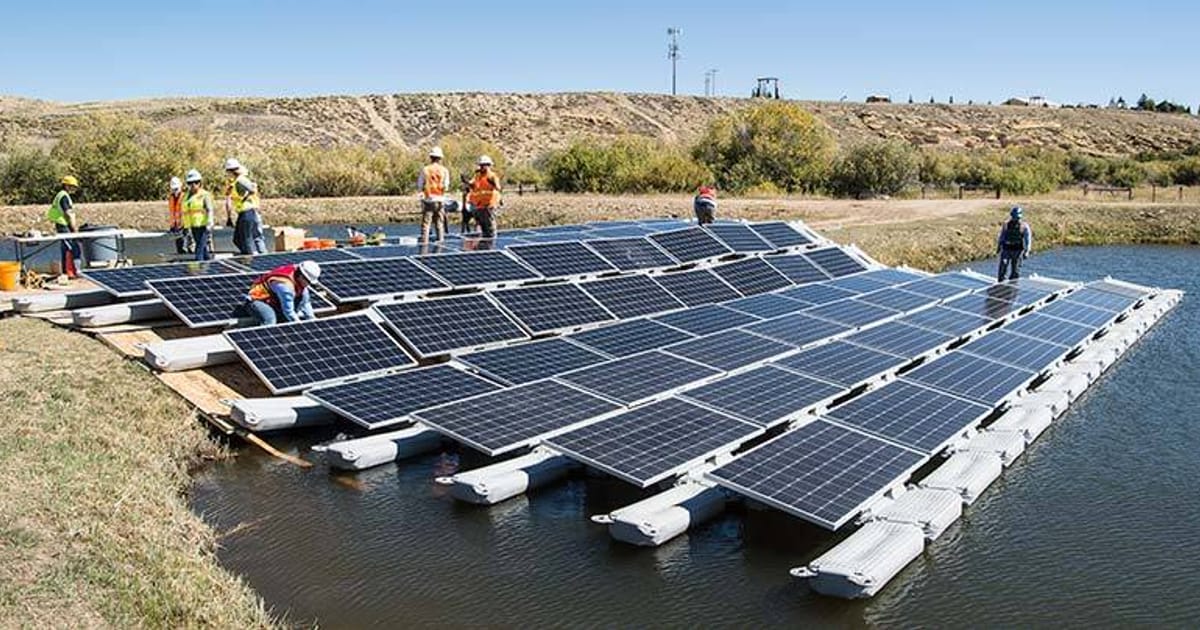This story was first published by Grist.
A reservoir is many things: a source of drinking water, a playground for swimmers, a refuge for migrating birds. But if you ask solar-power enthusiasts, a reservoir is also not realizing its full potential. That open water could be covered with buoyant panels, a burgeoning technology known as floating photovoltaics, aka “floatovoltaics.” They could simultaneously gather energy from the sun and shade the water, reducing evaporation — an especially welcome bonus where droughts are getting worse.
Now, scientists have crunched the numbers and found that if humans deployed floatovoltaics in a fraction of lakes and reservoirs around the world — covering just 10 percent of the surface area of each — the systems could collectively generate four times the amount of power the United Kingdom uses in a year. The effectiveness of so-called FPVs would vary from country to country, but their research found that some could theoretically supply all their electricity this way, including Ethiopia, Rwanda, and Papua New Guinea.
“The countries around the world that we saw gain the most from these FPVs were these low-latitude, tropical countries that did not have a high energy demand in the first place,” said Iestyn Woolway, an Earth system scientist at Bangor University and lead author of a new paper describing the findings in the journal Nature Water. “It meant that if only a small percentage of their lakes — this 10 percent — was covered by FPVs, it could be enough to fuel the energy demand of the entire country.”
For developing countries, floatovoltaics could be especially powerful as a means of generating clean electricity. Instead of building out more planet-warming infrastructure running on fossil fuels, like gas-fired power plants, fledgling economies could run panels on land and water, in addition to other renewables like wind and hydropower. With solar power comes autonomy: Utilities don’t have to rely on shipments of fossil fuels, but can tap into the abundant power of the sun.
Floatovoltaic solar panels — which have been proliferating globally, from California to France to Taiwan — are the same ones found on a rooftop. “It’s the same electrical system, same panels, same inverters,” said Chris Bartle, director of sales and marketing at Ciel and Terre USA, which is deploying floatovoltaic systems. “We’re just providing a structure that floats to mount that electrical system.” The solar rafts are anchored either to the bottom of the water body or to the shore, or both, to keep them from wandering.
In many ways, solar panels and bodies of water can benefit one another. Photovoltaics get less efficient the hotter they get, so having them floating on a lake or reservoir helps cool them off. “Because of the cooling effect, we see increased efficiency of the systems,” said Sika Gadzanku, a researcher at the National Renewable Energy Laboratory in Colorado, who studies floatovoltaics but wasn’t involved in the new research. Returning the favor, the panels provide shading, reducing evaporation. If floatovoltaics are spread across a reservoir, that could mean more water would be available for drinking.
If a reservoir is equipped with a dam for hydroelectric generation, the floatovoltaics could hook into that existing transmission infrastructure. (Countries like Kenya, for instance, are building out more of this hydroelectric infrastructure already.) That could save local governments money because they wouldn’t need to string new transmission lines from the floatovoltaics to the nearest city. In the event of a drought, when water levels drop too low to generate hydropower, the panels could still operate as backup power.
To do their new modeling, Woolway and his colleagues began with over a million lakes and reservoirs around the world big enough and deep enough for floatovoltaics. Then they whittled those down based on critical qualities. For one, the body of water couldn’t dry up, beaching the panels, or freeze over for more than six months a year, entombing the panels in ice and damaging them. The lake couldn’t be protected by law, either, like as a natural refuge. And the site had to be near a human population that could use the generated power.
A remote lake, by contrast, would require long transmission lines to connect a faraway city to the floatovoltaics. This doesn’t necessarily rule out the technology for more remote communities of people living near an otherwise suitable lake. In fact, floatovoltaics could be particularly potent there as a way to provide clean energy. These cases just weren’t included in the scope of this modeling.
This post was originally published on 3rd party site mentioned in the title of this site






